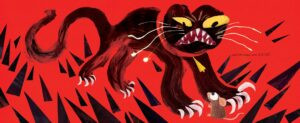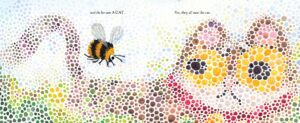Picture books often serve as a child’s first foray into the world of literature, and for adults, they can be a delightful rediscovery of simple yet profound storytelling. Among the vast landscape of children’s literature, “Cat Books” hold a special place, often capturing the enigmatic nature of our feline companions. Brendan Wenzel’s “They All Saw a Cat” stands out not just as another charming cat book, but as a brilliantly conceived exploration of perception, empathy, and the beauty of diverse perspectives, all wrapped in a visually stunning package. This isn’t just a story about a cat; it’s an artistic and narrative journey that subtly teaches profound lessons about how we see the world and each other.
Alt text: Cover of the children’s book “They All Saw a Cat” by Brendan Wenzel, featuring a stylized cat illustration with various textures and colors.
The narrative premise is deceptively simple: “The cat walked through the world, with its whiskers, ears, and paws…” As this feline protagonist journeys, it encounters a variety of creatures – a child, a dog, a fox, a fish, a mouse, a bee, a bird, a flea, a snake, a skunk, a worm, and finally, a bat. What makes this cat book truly exceptional is how Wenzel depicts the cat through the eyes of each observer. Each animal perceives the cat in a way that is unique to their own sensory experiences and understanding of the world. For a child, the cat is perhaps a familiar, soft pet. For a dog or a fox, it might be seen as prey or a creature defined by scent and sound. For a mouse, the cat could be a terrifying predator.
This ingenious approach immediately sets “They All Saw a Cat” apart from typical cat books. It transcends the simple adoration of cats and delves into the fascinating realm of subjective reality. The book cleverly uses the cat as a central figure to illustrate how perception is not a universal constant but rather a personal interpretation shaped by individual experiences and biological predispositions.
The genius of this cat book lies not only in its concept but also in its execution. Wenzel masterfully employs a range of artistic styles and palettes to visually represent each animal’s perspective. When the child sees the cat, the illustrations are rendered in soft, familiar tones. In contrast, the mouse’s view of the cat is a dramatic, almost abstract explosion of sharp angles, teeth, and claws against a vibrant red backdrop, instantly conveying fear and danger. The snake’s vision bursts with vibrant, contrasting colors, reflecting how snakes perceive heat signatures, while the skunk’s view is presented in muted, grainy sepia tones, perhaps hinting at a world sensed through scent.
 theyallsaw2
theyallsaw2
Alt text: A two-page spread from “They All Saw a Cat” showcasing contrasting visual interpretations of the cat; on the left, a vibrant, colorful depiction representing snake vision, and on the right, a grainy, sepia-toned image for skunk vision.
This artistic diversity is not merely for visual appeal; it is integral to the book’s message. By showcasing such varied depictions of the same cat, Wenzel encourages young readers to recognize that there isn’t one single “true” way of seeing. Each perspective is valid and shaped by the observer’s unique lens. This cat book subtly introduces children to the concept of empathy – understanding that others may experience the world differently.
Beyond the core theme of perception, “They All Saw a Cat” operates on multiple layers. It’s a science book in disguise, hinting at the diverse sensory worlds of different animals. It’s an art book, showcasing a stunning array of artistic techniques – as the publication page playfully notes, the illustrations were created using “almost everything imaginable, including colored pencil, oil pastels, acrylic paint, watercolor, charcoal, Magic Marker, good old number 2 pencils, and even an iBook.” And, fundamentally, it’s a beautifully written cat book, with simple, repetitive sentences that are both soothing and thought-provoking, perfectly mirroring the enigmatic and independent nature of a cat.
The rhythmic text, “The cat walked through the world…”, repeated throughout the book, provides a comforting structure while the illustrations continuously surprise and challenge our visual expectations. This interplay between textual repetition and visual variation keeps readers of all ages engaged and encourages deeper thinking about the core message.
 theyallsaw4
theyallsaw4
Alt text: Illustration from “They All Saw a Cat” depicting a human perspective of the cat, rendered in soft, approachable colors and lines, contrasting with the more abstract and sensory-focused animal perspectives shown elsewhere in the book.
“They All Saw a Cat” culminates with the cat looking at its reflection in water, prompting the reader to ponder, “and imagine what it saw?” This open-ended conclusion encourages further discussion and reflection. What does the cat see itself as? Does it have its own singular perspective, or is it a composite of all the ways it is perceived by others? This cat book leaves us with more questions than answers, fostering a sense of wonder and intellectual curiosity.
For parents, educators, and anyone seeking a children’s book that is both visually captivating and intellectually stimulating, “They All Saw a Cat” is an exceptional choice. It’s more than just a charming story about a feline; it’s a sophisticated exploration of perception and empathy, cleverly disguised within the accessible format of a cat book. It’s a book that will be enjoyed on multiple levels, sparking conversations about different viewpoints and the richness of diverse experiences. Forget the tired “cat person” versus “dog person” debate – this book is for everyone. It gently reminds us that understanding begins with recognizing that we all see the world through our own unique lenses. And what better way to begin teaching this vital lesson than through the captivating perspectives offered in this remarkable cat book?
